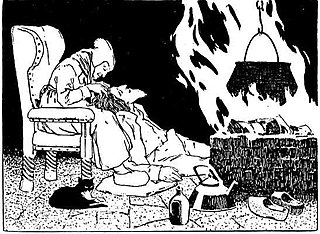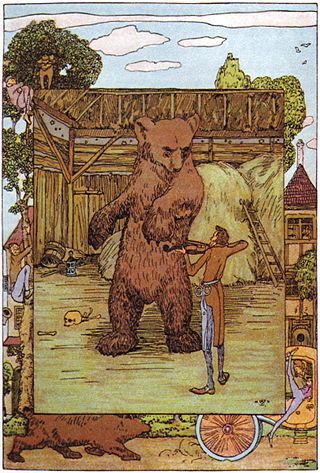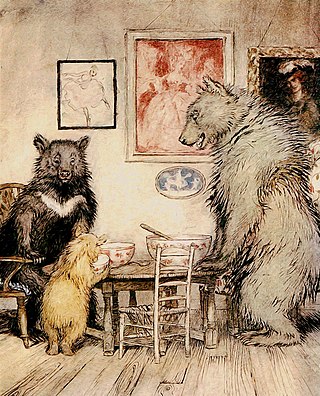Related Research Articles

In Greek mythology, Callisto or Kallisto was a nymph, or the daughter of King Lycaon; the myth varies in such details. She was believed to be one of the followers of Artemis who attracted Zeus. Many versions of Callisto's story survive. According to some writers, Zeus transformed himself into the figure of Artemis to pursue Callisto, and she slept with him believing Zeus to be Artemis. She became pregnant and when this was eventually discovered, she was expelled from Artemis's group, after which a furious Hera, the wife of Zeus, transformed her into a bear, although in some versions Artemis is the one to give her an ursine form. Later, just as she was about to be killed by her son when he was hunting, she was set among the stars as Ursa Major by Zeus. She was the bear-mother of the Arcadians, through her son Arcas by Zeus.

Ursa Major is a constellation in the northern sky, whose associated mythology likely dates back into prehistory. Its Latin name means "greater bear", referring to and contrasting it with nearby Ursa Minor, the lesser bear. In antiquity, it was one of the original 48 constellations listed by Ptolemy in the 2nd century AD, drawing on earlier works by Greek, Egyptian, Babylonian, and Assyrian astronomers. Today it is the third largest of the 88 modern constellations.

The Wild Hunt is a folklore motif occurring across various northern European cultures. Wild Hunts typically involve a chase led by a mythological figure escorted by a ghostly or supernatural group of hunters engaged in pursuit. The leader of the hunt is often a named figure associated with Odin in Germanic legends, but may variously be a historical or legendary figure like Theodoric the Great, the Danish king Valdemar Atterdag, the dragon slayer Sigurd, the Welsh psychopomp Gwyn ap Nudd, biblical figures such as Herod, Cain, Gabriel, or the Devil, or an unidentified lost soul or spirit either male or female. The hunters are generally the souls of the dead or ghostly dogs, sometimes fairies, valkyries, or elves.

The world tree is a motif present in several religions and mythologies, particularly Indo-European religions, Siberian religions, and Native American religions. The world tree is represented as a colossal tree which supports the heavens, thereby connecting the heavens, the terrestrial world, and, through its roots, the underworld. It may also be strongly connected to the motif of the tree of life, but it is the source of wisdom of the ages.
The Aarne–Thompson–Uther Index is a catalogue of folktale types used in folklore studies. The ATU Index is the product of a series of revisions and expansions by an international group of scholars: originally composed in German by Finnish folklorist Antti Aarne (1910), the index was translated into English, revised, and expanded by American folklorist Stith Thompson, and later further revised and expanded by German folklorist Hans-Jörg Uther (2004). The ATU Index, along with Thompson's Motif-Index of Folk-Literature (1932) – with which it is used in tandem, is an essential tool for folklorists.
Comparative mythology is the comparison of myths from different cultures in an attempt to identify shared themes and characteristics. Comparative mythology has served a variety of academic purposes. For example, scholars have used the relationships between different myths to trace the development of religions and cultures, to propose common origins for myths from different cultures, and to support various psychoanalytical theories.

The swan maiden is a mythical creature who shapeshifts from human form to swan form. The key to the transformation is usually a swan skin, or a garment with swan feathers attached. In folktales of this type, the male character spies the maiden, typically by some body of water, then snatches away the feather garment, which prevents her from flying away, forcing her to become his wife.
A krsnik or kresnik is a type of vampire hunter, a shaman whose spirit wanders from the body in the form of an animal. The krsnik turns into an animal at night to fight off the kudlak, his evil vampire antithesis, with the krsnik appearing as a white animal and the kudlak as a black one. The krsnik's soul leaves the body, either voluntarily or due to a higher power, to fight evil agents and ensure good harvest, health, and happiness.

Coyote is a mythological character common to many cultures of the Indigenous peoples of North America, based on the coyote animal. This character is usually male and is generally anthropomorphic, although he may have some coyote-like physical features such as fur, pointed ears, yellow eyes, a tail and blunt claws. The myths and legends which include Coyote vary widely from culture to culture.

The Big Dipper or the Plough is a large asterism consisting of seven bright stars of the constellation Ursa Major; six of them are of second magnitude and one, Megrez (δ), of third magnitude. Four define a "bowl" or "body" and three define a "handle" or "head". It is recognized as a distinct grouping in many cultures. The North Star (Polaris), the current northern pole star and the tip of the handle of the Little Dipper, can be located by extending an imaginary line through the front two stars of the asterism, Merak (β) and Dubhe (α). This makes it useful in celestial navigation.

"The Devil with the Three Golden Hairs" is a German fairy tale collected by the Brothers Grimm. It falls under Aarne–Thompson classification types 461, and 930.

"The Clever Little Tailor" is a German fairy tale collected by the Brothers Grimm as tale 114. It is Aarne-Thompson type 850, The Princess's Birthmarks. Andrew Lang included it in The Green Fairy Book.
Elements of a Proto-Uralic religion can be recovered from reconstructions of the Proto-Uralic language.

Inuit astronomy is centered around the Qilak, the Inuit name for the celestial sphere and the home for souls of departed people. Inuit beliefs about astronomy are the shaped by the harsh climate in the Arctic and the resulting difficulties of surviving and hunting in the region. The stars were an important tool to track time, seasons, and location, particularly during winter.

A dragonslayer is a person or being that slays dragons. Dragonslayers and the creatures they hunt have been popular in traditional stories from around the world: they are a type of story classified as type 300 in the Aarne–Thompson classification system. They continue to be popular in modern books, films, video games and other forms of entertainment. Dragonslayer-themed stories are also sometimes seen as having a chaoskampf theme - in which a heroic figure struggles against a monster that epitomises chaos.

High visibility of the star cluster Pleiades in the night sky and its position along the ecliptic has given it importance in many cultures, ancient and modern. Its heliacal rising, which moves through the seasons over millennia was nonetheless a date of folklore or ritual for various ancestral groups, so too its yearly heliacal setting.
The origin of death is a theme in the myths of many cultures. Death is a universal feature of human life, so stories about its origin appear to be universal in human cultures. As such it is a type of origin myth, a myth that describes the origin of some feature of the natural or social world. No one type of these myths is universal, but each region has its own characteristic types. Such myths have therefore been a frequent topic of study in the field of comparative mythology.

The corpus of traditional riddles from the Finnic-speaking world is fairly unitary, though eastern Finnish-speaking regions show particular influence of Russian Orthodox Christianity and Slavonic riddle culture. The Finnish for 'riddle' is arvoitus, related to the verb arvata and arpa.
Marina Bartsyts is an anthropologist and former politician from Abkhazia.

Bears have been depicted throughout history by many different cultures and societies. Bears are very popular animals that feature in many stories, folklores, mythology and legends from across the world, ranging from North America, Europe and Asia. In the 20th century bears have been very popular in pop culture with several high profile characters and stories with depictions of bears e.g. Goldilocks and the Three Bears, Rupert Bear, Paddington Bear and Winnie the Pooh.
References
- 1 2 d'Huy, Julien (2016). "Scientists Trace Society's Myths to Primordial Origins". No. December. Scientific American . Retrieved 15 December 2016.
- 1 2 d'Huy, Julien (2013). "A Cosmic Hunt in the Berber sky: : a phylogenetic reconstruction of a Palaeolithic mythology". Les Cahiers de l'AARS. 16: 93–106. Retrieved 15 December 2016.